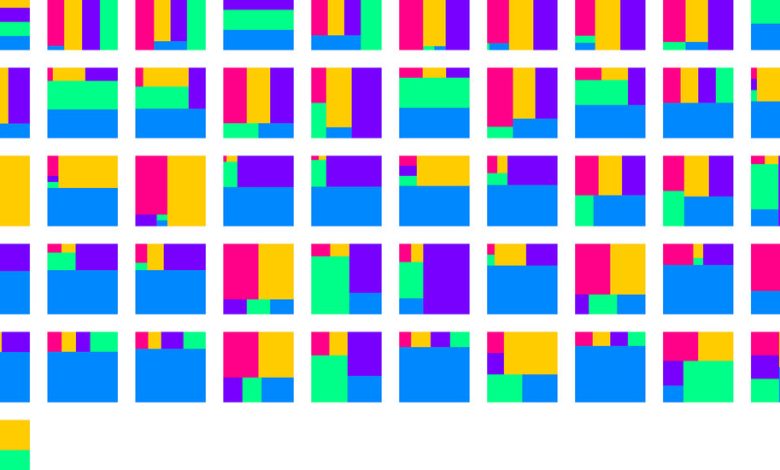The Quest to Find Rectangles in a Square

Lisanne Taams, a student at Radboud University in the Netherlands, is working on a Ph.D. about, in her words, “computing motives of moduli stacks of vector bundles on stacky curves.”
“It took me two years to even say that properly,” Ms. Taams said. But, she added, such heights of abstraction only elevated her delight as she recently spent time on a more concrete contemplation: counting the ways that a square can be divided into similar rectangles.
She found this geometric puzzle on Mathstodon, a community within the social network Mastodon. Created in the spring of 2017 by two mathematicians in England, Christian Lawson-Perfect and Colin Wright, registered accounts on Mathstodon totaled about 3,000 in September. Since then, with the Twitter exodus, the number has since increased to around 13,000.
The puzzle was posted in December by John Carlos Baez, a mathematical physicist at the University of California, Riverside.
“There are three ways to divide a square into three rectangles with the same proportions!” Dr. Baez wrote.
He illustrated the answer with three images that he borrowed from Wikipedia:

Credit…David Eppstein
In the image on the left, the rectangles are three times as long as they are wide, he explained in an email. In the middle image, the rectangles are one-and-a-half times as long as they are wide. “The third solution is trickier,” Dr. Baez said. The rectangles are “about 1.75487 times as long as they are wide, though one rectangle is turned around so it’s short and squat,” he added.
Dr. Baez noted that the number 1.75487 is of interest to mathematicians. “It’s the square of the ‘plastic ratio,’” he said, “which is a number that has a lot of properties similar to the more famous ‘golden ratio.’”
Having laid that foundation, Dr. Baez asked his Mathstodon followers: “What if you chop a square into four similar rectangles? What proportions can they have?”
Among the first to take the bait was Rahul Narain, a computer scientist at the Indian Institute of Technology, Delhi. “I was on Mastodon before it was cool,” he says in his bio (he joined in December 2017). “And the fact that all the cool people are here now is a bit unsettling.”
Dr. Narain sketched out a systematic strategy for solving the puzzle, though he hoped someone else would carry it out. As he said in his reply to Dr. Baez, “I really have other things I need to work on right now, I can’t afford to get nerd-sniped any more than this!”
There turned out to be 11 solutions — 11 ways a square can be divided into four similarly proportioned rectangles. The solutions gradually accumulated with crucial input from Ian Henderson, an independent software developer in the Bay Area, and Daniel Piker in Bristol, England, who works as a design systems analyst developing software for architects at Foster + Partners.
And a lot of other people also helped, Dr. Baez said. “That’s why it was fun.”
Ms. Taams found 11 solutions by hand and soon discovered that she had made a few mistakes. She then decided to let the computer do the work. She wrote software and generated some images. But when she checked the progress online, “I saw other people already had a lot more pictures,” Ms. Taams said.
Mr. Piker, who enjoys making geometric animations, had drawn all 11 options:
The simplicity of the problem is what drew him. “I thought it was kind of cool that there was something so simple that apparently hadn’t been looked at before,” Mr. Piker said.
However, he added, “The maths quickly went beyond my understanding.”
He could make sense of a proof posted by Ms. Taams, though it was not something that he would have easily produced. She posted an 11-part thread — with technical passages composed with LaTeX, a scientific typesetting language — showing that this humble geometry puzzle is connected to more serious and formal mathematics.
In other words, she came up with a proof that the ratio of the long sides to the short sides are “algebraic numbers,” a major topic in number theory.
“I don’t think we’ve gotten anywhere near the bottom of this yet,” Dr. Baez said. “But it’s a good step.”
Sarah Hart, a mathematician at Birkbeck, University of London — whose book, “Once Upon a Prime,” which explores connections between mathematics and literature, comes out in April — called this rectangulation recreation “awesome” and “lovely.” (She had not partaken in the Mathstodon pursuit.)
“What makes a problem lovely?” she said. “That’s a tricky one.” For Dr. Hart, it helps if the problem is easy to describe, and easy to play with — “you can get your hands dirty straight away with simple examples.” And if it “becomes deliciously complex and challenging.”
Dr. Hart also noted that “a lot of the most interesting problems come from recreations like this.”
Ms. Taams found her proof computationally, and then pondered it further. The computations produced a set of equations, she said. “And then you wonder, ‘Oh, are these all the equations? Yes or no?’” She convinced herself the answer was “Yes” by just looking at three examples. “It’s a little bit hard to argue why. If you stare at the pictures, you sort of see it.”
(More formally, Ms. Taams proved that when conducting a similar rectangulation of a square — that is, dividing it into a number, N, of similar rectangles — the ratio is an algebraic number of degree at most N.)
The online discussion at one point turned to a similar investigation into “squaring the square” by William Tutte and his collaborators in the 1930s, which is related to electrical circuit theory.
“It turns out you can think of the height and width of each square as related to voltage and current in an electrical circuit — and using this, you can find ways to ‘square the square’ using electrical circuit theory,” Dr. Baez said by email. “Something like this is also true for the rectangle dissection problem, but we haven’t exploited it yet.”
David Eppstein, a computer scientist at the University of California, Irvine, commented that the term “guillotine partition” is the standard way to describe the process of recursively slicing off, vertically or horizontally, rectangular pieces from a square. Jules Hedges, a computer scientist at the University of Strathclyde, Glasgow, suggested that “Mondrian” — after the Dutch abstract artist Piet Mondrian — might also be a fitting name for this process. This prompted Stefano Gogioso, a computer scientist at the University of Oxford, to point out that, “in machine learning, Mondrian tree/forests is used to denote a certain kind of classification performed by guillotine cuts.”
Returning to the matter of the 11 four-way rectangulations: This result was confirmed with two batches of code, one by Dr. Narain, enumerating and testing all the guillotine partitions, and one by Mr. Henderson using a more involved approach.
They didn’t stop there.
“The question appeared in my mind, ‘Oh, what about five? What about six?’” Mr. Henderson said.
Both he and Dr. Narain found 51 solutions when it came to dividing a square into five similar rectangles:
Mr. Henderson found 245 possible rectangular proportions that divide a square into six similar rectangles, and 1,371 options for seven similar rectangles. Initially, he gave up on eight rectangles — he tried, but the program just kept running. Eventually, it ran out of memory.
“I got it out of my system,” he said.
But then he circled back and went troubleshooting and realized that there was something amiss with the code for eight rectangles. “In any case, with this fixed, it does actually finish running,” Mr. Henderson said in his email. “There are (according to the code, at least) 8,506 different aspect ratios for eight rectangles.” He may try for nine.




